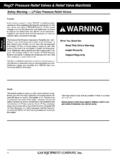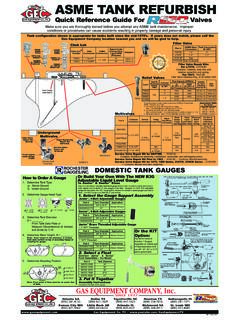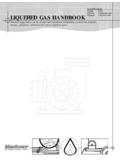Transcription of Rego Section 2 2006 - Gas Equipment
1 251 HosesHosesIMPORTANT INFORMATION:Product must be installed and used in strict conformance with NFPA Pamphlet 58 and/or NFPA Pamphlet 54 and all other codes, regulations and manufac-turer to follow these codes, regulations and recommendationscould result in hazardous installation, bodily injury and/or TRAINING SCHOOLS a GECcustomer service representative for more :LP Gas is extremely flammable and used for handling LP Gas and Anhydrous Ammonia mustbe installed and used in strict conformance with NFPA Pamphlet58 and 54 and all other codes, regulations and manufacturer InformationHosesFailure to follow recommended application information andrecommended procedures for selection, installation, care,maintenance and storage of hose, couplings or hose assem-blies may result in failure to perform properly and may resultin damage to property and serious bodily injury.
2 Make surethat hose selected for any application is recommended forthat service. Application information is given with each hoseor coupling listing in the Dayco catalog. Refer to the Safetyand Technical Data Section of this catalog for informationregarding safety, care, maintenance and storage. Contactyour local Distributor for any application, there may be inherent risk of bodily injuryor property damage and the user is responsible for imple-mentation of adequate safety Gas Hose:This discussion again emphasizes the impor-tance of hose selection. LP Gas has volatile characteristics thatrequire special hose construction.
3 The rubber compounds mustbe designed to handle LP Gas, and the cover must be perforatedto prevent gas build-up among the various layers of the hose. Useof the wrong hose may lead to early and sudden failure. In partic-ular, anhydrous ammonia hose is not recommended for LP Gasservice. This is important to emphasize because both types ofhose are often used in the same area and care must be takenthey do not become accidentally switched. DO NOT USE LP GASHOSE FOR ANHYDROUS AMMONIA. Couplings are also a con-cern in this service; permanent crimp steel couplings are recom-mended, as well as high-pressure steel inserts attached withinterlocking, bolt-on with male swivel end styles are not recommended.
4 DONOT USE WITH SCREW-TOGETHER REATTACHABLE COU-PLINGS. (Refer to RMA Publication IP-10 Liquid Petroleum Gas,Specifications for ).WARNING:For LP Gas use ONLY. Do not use for anhydrousammonia. Do not use with any fluid or vapor other than the intend-ed use for which the hose was designed. Do not use with maleswivel couplings. Do not use with screw-together reattachable :Safety in the application and use of industrial hose isa major concern because of the many potentially dangerousproducts conveyed, and because so many people are these products can be accomplished safely if a few sim-ple precautions are strictly observed.
5 Some of the most importantof these are: All operators must be thoroughly trained. The correct hose must be selected to handle the application. The couplings must be correct for the application and also mustbe securely attached. Both hose and couplings should be well maintained and inspect-ed , Care, Maintenance and Storage(REPRINTED FROM RMA HOSE HAND-BOOK IP-2 SIXTH EDITION 1996)Hose has a limited life and the user must be alert to signs ofimpending failure, particularly when the conditions of serviceinclude high working pressures and/or the conveyance or con-tainment of hazardous WARNING.
6 Failure to properly follow the man-ufacturer s recommended procedures for the care, mainte-nance and storage of a particular hose might result in its fail-ure to perform in the manner intended and might result indamage to property and serious bodily refer to RMA (Rubber Manufacturer s Association)HOSE HANDBOOK IP-2 SIXTH EDITION 1996, or later for theproper use, care and maintenance of Test and Inspection Procedures for Hose*REFERENCE NPGA TECHNICAL BULLETIN T145 AND T114T145 Hoses and Flexible Connectors used in Plants andCargo Vehicles T114 Guide to Hose Inspection An inspection and hydrostatic test should be made at periodicintervals to determine if a hose is suitable for continued visual inspection of the hose should be made for loose covers,kinks, bulges or soft spots which might indicate broken or dis-placed reinforcement.
7 The couplings or fittings should be closelyexamined and, if there is any sign of movement of the hose fromthe couplings, the hose should be removed from service. Theperiodic inspection should include a hydrostatic test for oneminute at 150% of the recommended working pressure of thehose. During the hydrostatic test, the hose should be straight, notcoiled or in a kinked position. Water is the usual test medium and,following the test, the hose may be flushed with alcohol to removetraces of moisture. A regular schedule for testing should be fol-lowed and inspection records WARNING Before conducting any pressuretests on hose, provisions must be made to ensure the safetyof the personnel performing the tests and to prevent anypossible damage to property.
8 Only trained personnel usingproper tools and procedures should conduct any REFER TO NPGA TECHNICAL BULLETIN T145 ON HOSES AND FLEXIBLE CONNECTORS USED IN PLANTSAND CARGO VEHICLES and T114 GUIDE TO HOSEINSPECTION .HOSE SAFETY AND TECHNICAL INFORMATIONWARNING SAFETY NOTE253 Technical InformationHosesHOSE TECHNICAL UPDATE Subject: LP Gas Hose/Assemblies Permeation Concerns Date: March 30, 2004 In recent years there have been concerns about the permeation of LP Gas through LP Gas hose. While wet orsitting in water, bubbling has been observed from the pinprick holes in the cover.
9 Others have observed gas slowlyescaping from the area where the ferrule attaches to the coupling insert. Some users have wrongly assumed this tobe excessive permeation or leakage. One source of perceived leakage is the escape of air that is trapped in the reinforcement of the hose. This type ofperceived leakage is most commonly noticed during the pressure testing of a hose assembly. When LP Gas hoseis pressurized, air that has been trapped in the reinforcement of the hose can be squeezed out through theventing/pinprick holes in the cover, or out the cut end of the hose. In the presence of moisture, this may beapparent as bubbling at the pinprick holes in the cover or as air escaping out the area where the ferrule is attachedto the insert.
10 This escape of trapped air through the pinholes and the coupling should diminish over time and shoulddisappear after 1-4 hours of pressurization. Generally, the air escaping from the pinprick holes will dissipate at amuch more rapid rate than the air escaping at the coupling. The most common perceived leakage is the "normal" escape of permeating gas through the hose wall. The pinprickholes concentrate the permeation to specific areas of the cover. Due to the presence of moisture, this concentrationof permeation can be observed as bubbling. In some instances this permeating gas may travel down thereinforcement of the hose and escape out the end of the hose.









